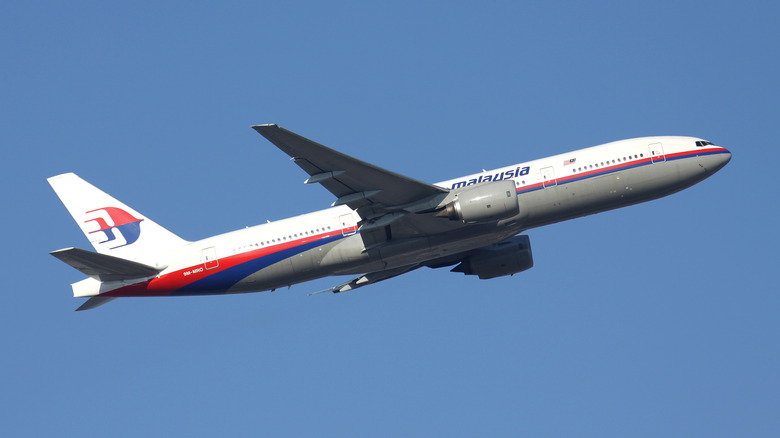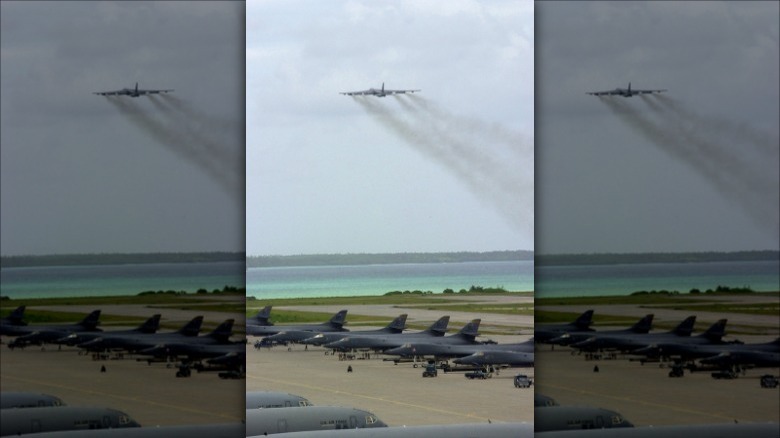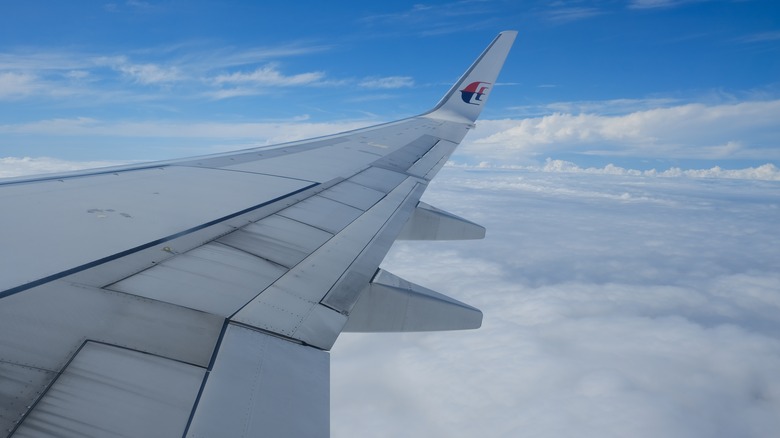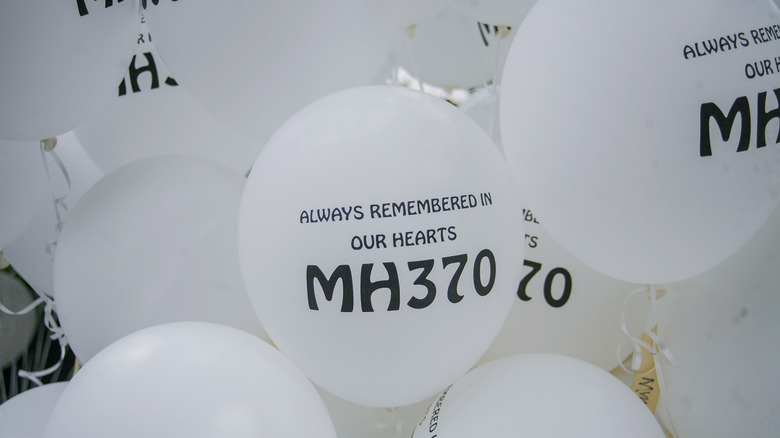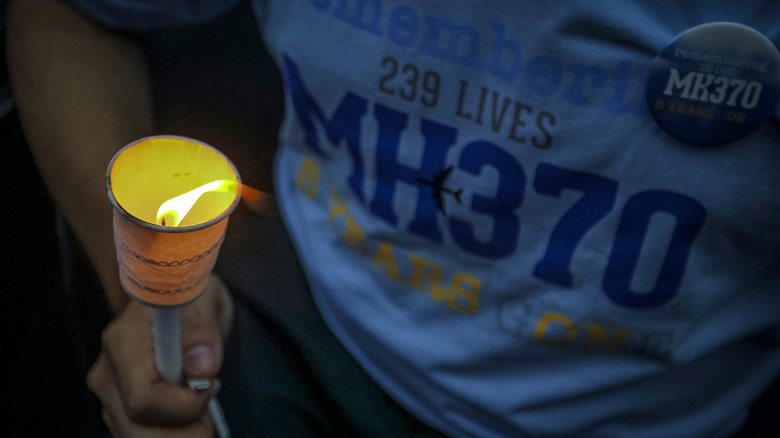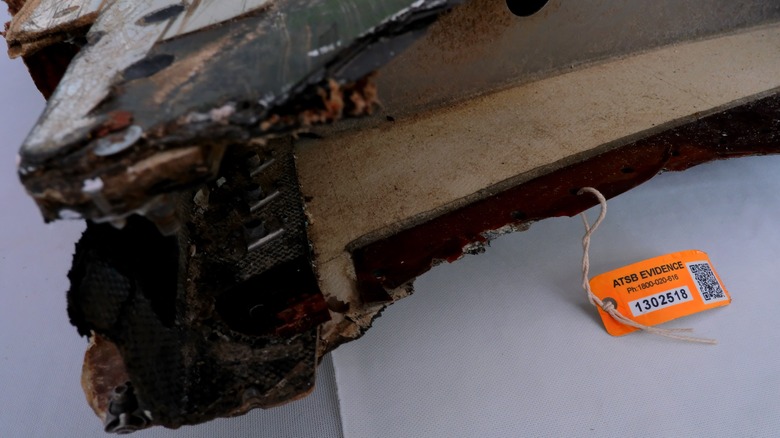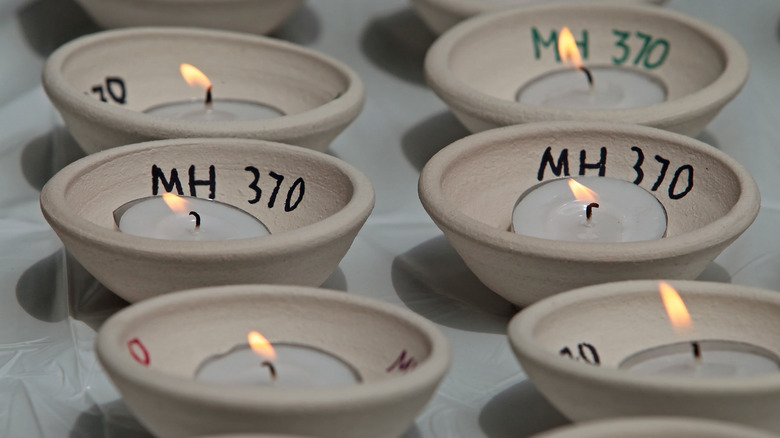Malaysia Flight 370: The Biggest Theories About What Happened
On March 8, 2014, news broke that a commercial airliner flying from Kuala Lumpur — Malaysia Airlines flight MH370 — had disappeared, with air traffic control suddenly unable to find the plane on radar systems. The loss of contact led to an enormous search operation, beginning in the area where the plane was last detected by military radar: the Straight of Malacca, where the aircraft suddenly lost contact some 90 minutes into the journey. The Boeing 777 was carrying 227 passengers and 12 crew members, whose families and friends waited desperately for updates as the search widened across the South China Sea and beyond. The most likely explanation for the plane's disappearance, it seemed, was that it had crashed into the ocean.
But with no confirmation of the location of the plane or even any signs of debris from the supposed crash, news outlets, public figures, and online armchair detectives took it upon themselves to try to piece together what happened. The result was a wide range of unverified theories ranging from credible to outlandish, including a number of fanciful conspiracy theories. According to New Scientist's Rob Brotherton, conspiratorial thinking is a common human response to huge new stories for which there is no solid explanation, and as the weeks and months rolled on with no trace of the plane or any of those onboard, many of these conspiracy theories persisted.
Here are the most prominent theories concerning the fate of flight MH370, both credible and incredible.
Theory: It was a terrorist attack
Though more than a decade had passed since the terrible events of September 11, 2001, headline news stories concerning a missing plane raised the specter of that day's terror attacks and led many to believe similar events had transpired in relation to Malaysia Airlines flight MH370.
Some outlets, such as The Daily Telegraph, pointed to the testimony of an Al-Qaeda informant named Saajid Muhammad Badat, who claimed in court that a group of terrorists based in Malaysia was planning to take control of a commercial plane using a homemade bomb. Days after flight MH370 went missing, investigators released information that the plane's communication systems appeared to have been intentionally turned off leading to air traffic control losing contact, which some argued was consistent with a hijacking scenario.
One figure who seemed to subscribe to the theory that Al-Qaeda had taken control of MH370 was Fox News owner and media mogul Rupert Murdoch, who tweeted: "777crash confirms [terrorists] turning to make trouble for China. Chance for US [sic] to make common cause, befriend China while Russia bullies." He went on to claim, without any evidence, that the plane may not have crashed, but had been stolen and was now being hidden in Pakistan, raising the eyebrows of several news outlets.
Theory: The plane was hijacked by North Korea
Al-Qaeda wasn't the only group blamed for the disappearance of Malaysia Airlines flight MH370 by various news sources and online commentators. As outlets cast around for any potentially suspicious scenarios, looking for people who could have been responsible for the disappearance of a plane carrying 239 people, North Korea was soon identified as another possible suspect.
Having first emerged on social media — where the idea attracted more derision than genuine interest — the story soon broke through to the tabloids, thanks in part to an editorial on eTurboNews, which claimed to have received inside information from a professional in the aviation industry. The alleged source speculated that the plane had been hijacked at the behest of North Korean dictator Kim Jong-un (pictured) as a way of accessing technology on board the Boeing 777 that was not available in the country at the time. North Korea had been responsible for the hijacking of a Korean passenger plane in 1969, an incident to which many tabloids drew parallels.
Theory: It was diverted to a U.S. base
In the rush to identify perpetrators behind the disappearance of Malaysia Airlines flight MH370, a number of cyber-sleuths pointed the finger at one very large target indeed: the United States.
In July 2015, news broke that a piece of debris potentially belonging to the missing plane had washed up on Réunion, an island in the Indian Ocean controlled by France. By then, many conspiracy theories were already circulating about the fate of the plane, and one canny Twitter user asked: "How long before conspiracy theorists start bringing up #diegogarcia and it's [sic] location in relation to reunion island #mh370".
Diego Garcia is a British territory in the Indian Ocean home to a U.S. naval base, near where MH370 is believed to have gone missing. Before long, theories spread that the United States had for some unknown reason intercepted the aircraft and diverted it to the base, while another unsubstantiated rumor held that the plane had actually been shot down by the American military. Though the missing plane indeed appeared on radars not far from Diego Garcia, U.S. officials ruled out any chance it had landed at the military base very early on.
Theory: The plane was carrying patent-holding scientists
Some of the stories told online about how and why Malaysia Airlines flight MH370 went missing were more compelling than others. One, in particular, gained significant traction online, as it was suggestive of a murderous plot orchestrated by big business purely for the sake of profit.
As reported by Reuters in the aftermath of MH370's disappearance, among the 227 passengers onboard was a group of 20 engineers and scientists from Malaysia and China, all employees of Freescale Semiconductor, a San Francisco-based chip-making company. As renowned experts in the field of electronics, their loss was said to have had a huge impact on the company, whose CEO Gregg Lowe said: "These were people with a lot of experience and technical background and they were very important people ... It's definitely a loss for the company."
Of course, conspiracy-minded internet sleuths read more into the fact that renowned scientists were passengers aboard MH370. When the news broke, a rumor began to circulate that several of those onboard were co-holders of a lucrative patent in the field of chip-making, and that the plane therefore must have been purposefully downed so that others connected to the company could take full control of the intellectual assets. Though online posts insisting on the existence of such a scheme circulated for months after the plane's disappearance, the idea has been roundly debunked.
Theory: A Chinese group was responsible
As time went on and details of the missing plane's fate remained scant, many governments and groups were accused of perpetrating the disappearance of Malaysia Airlines flight MH370 ... and one little-known group even claimed responsibility.
That group, which called themselves the "Chinese Martyrs' Brigade," hit the news in many countries when they released a statement that read: "You kill one of our clan, we will kill 100 of you as pay back [sic]."
According to The Nation Thailand – one of the first news outlets to reveal the group's claims — the message was sent to a number of prominent journalists in China as an encrypted PDF via a service called Hushmail, meaning that its origin could not be traced. It was the first time the journalists had ever heard of the "Chinese Martyrs' Brigade," raising questions about whether the group truly existed and, if so, what they were attempting to do by leveraging the story of the missing passenger plane.
The same source states that the group's claim of involvement in the plane's disappearance was widely assumed to be a hoax circulated by "opportunists looking to inflame ethnic tensions" after political tensions and violence erupted between the Chinese authorities and separatists in the northwestern Chinese Uyghur autonomous region.
Theory: The passengers were alive somewhere
The terrible suffering of the friends and families of those onboard the missing Malaysia Airlines flight MH370 was widely reported in the aftermath of the plane's disappearance. Many of those directly impacted by the tragedy appeared in news bulletins and reports. And as the days rolled on, one story emerged from the missing passengers' loved ones that suggested hope — and a potential cover-up.
Nineteen families of those onboard MH370 found they received a dial tone, rather than voicemail, when attempting to call the cell phones of the missing passengers, suggesting the passengers' phones were intact and turned on — and therefore, that the plane had not crashed.
The families reportedly relayed this information to Malaysian authorities, who failed to engage with it, leading to a furious reaction from family members who claimed the government was not furnishing them with full information as to what happened.
However, NBC News later published an analysis dismissing the families' claims. In the story, wireless expert Jeff Kagan explains that just because a dial tone is received, there's not necessarily a connection to the phone in question. Rather, the network is "searching" for the phone in an attempt to make the connection.
Ultimately, the existence of a dial tone gave no real insight into the potential fate of the passengers.
Theory: A fire broke out
While some experts were making appearances in the media to limit broader speculation about what happened to Malaysia Airlines flight MH370, others were using their knowledge and experience to offer suggestions as to how and why the plane went missing.
One of these was Chris Goodfellow, a Canadian former pilot with 20 years of experience in the field. Like many of those in the aviation industry, Goodfellow turned to social media to discuss the disappearance with his friends and colleagues. The now-defunct Google+ published a lengthy post outlining his thoughts on what happened, which was considered so insightful that it was later picked up by Wired, who published it in full.
Goodfellow's theory was that MH370 was the victim of an incident on board, most likely an electrical fire or a fire related to the landing gear — Goodfellow points to a similar fire that happened to a Nigerian Airlines plane in 1991. The captain, Goodfellow suggests, unsuccessfully attempted an emergency landing.
Goodfellow even offered insight into the plane's unexpected trajectory. As many commentators noted in their brown explanations of the events, MH370 made a sudden turn in its final moments on radar, which some speculated meant that the plane had been purposefully taken off course and had landed somewhere. But Goodfellow believes that the experienced pilot was attempting to land in Palau Langkawi, a nearby airport toward which the plane turned.
Theory: It was shot down
With the world seemingly on tenterhooks waiting to find out what exactly happened to Malaysia Airlines flight MH370, some offered fanciful and intriguing theories about the plane's mysterious disappearance ... and cashed in on the news story in the process.
British writer Nigel Cawthorne worked intensively in the weeks after the plane's disappearance to write "Flight MH370: The Mystery," which was rush-released just two months after the plane went missing, when no trace of it had yet been uncovered. Cawthorne's theory was that MH370 had been shot down by the United States Air Force: an accident that tragically occurred during routine training exercises. Cawthorne then accused the U.S. and other governments around the world of conspiring together to cover up the accident and prevent the families of the victims from ever learning of the true fate of their loved ones.
The book was widely discredited upon its release, with several reviewers characterizing the book as cynical, irresponsible, and baseless in its assertions. More importantly, Malaysian authorities continued to insist that there was no evidence whatsoever that Malaysian Airlines flight MH370 had been shot down.
Theory: There was a cyber attack
Traditional military intervention wasn't the only way Malaysia Airlines flight MH370 might have been brought down from the outside, some said.
One theory that gained traction among tabloid news outlets, after being suggested by some former security experts, was that the plane may have been hit by a cyber attack, which disengaged its communication systems. In the reports, sources claimed that the security software of a Boeing 777 could be overridden by malware, with the attack triggered by nothing more than a regular cell phone. But as a detailed investigation by NPR points out, Boeing 777 planes are equipped with numerous communication systems that would be extremely difficult to override in one fell swoop. Indeed, former pilots argued that even those onboard would be unable to challenge the integrity of these systems, as they are "hardwired."
Boeing itself later released a statement challenging the credibility of reports that MH370 had been brought down by a cyber attack, dismissing them as speculation and insisting that the onboard computer systems of their aircraft were secure.
Theory: The pilot was responsible
Former pilot Chris Goodfellow noted the vast experience of MH370 captain Zaharie Ahmad Shah, who was reported as having accumulated 18,000 hours of flight time during his long career. However, relatively soon after the disappearance of the Malaysia Airlines plane, online commentators as well as several major news outlets turned their suspicions toward the 53-year-old captain, whom authorities suspected may have purposefully crashed the plane as an act of suicide, simultaneously killing everyone else onboard.
Though no black box has ever been recovered to substantiate these claims, the theory has gained more prominence in recent years, especially after a group of experts assembled by "60 Minutes" attested that the behavior of Shah at the controls was consistent with those of a pilot looking to make his own plane disappear from radar.
If you or anyone you know is having suicidal thoughts, please call the National Suicide Prevention Lifeline by dialing 988 or by calling 1-800-273-TALK (8255).
Theory: It was a tragic accident
When various governments confirmed the first discovery of debris from the missing Malaysia Airlines flight MH370 in July 2015, many of the more outlandish theories regarding the fate of the plane were seemingly debunked. But even before then, Malaysian authorities were quick to offer an official statement on the likely manner in which the plane was lost, and to provide some closure for the devastated families and friends of those onboard.
In January of that year, some nine months after the plane's unexplained disappearance, the Malaysian government issued an official statement through their Department of Civil Aviation Director-General, Azharuddin Abdul Rahman, according to the BBC. Rahman announced "with the heaviest heart and deepest sorrow" that the disappearance of the plane had been officially declared an accident, and that all 239 people on board were declared dead.
While some pointed out that the move assisted in the families' compensation claims against Malaysian Airlines — which, like the Malaysian government, came under pressure from Chinese authorities to ensure a swift payout — many of those affected refused to accept the declaration before more details of the ultimate fate of the plane were discovered.
Theory: The plane crashed at a vertical angle
Despite the recovery of various pieces of debris in the years since the plane's disappearance, the majority of Malaysia Airlines flight MH370 and the remains of those onboard have yet to be recovered. For many, it is something of a mystery as to how an enormous jumbo jet can disappear with such little trace of where exactly it ended up, or what precisely occurred to take it out of the sky.
In 2015, however, one group of academics — led by Texas A&M math professor Goong Chen — came forward with a theory that seemingly explained why recovery efforts undertaken by numerous governments in the aftermath of the disappearance of MH370 had failed.
Published in the journal of the American Mathematical Society, the researchers' work offered a model of how the Boeing 777 likely crashed into the Indian Ocean. The team suggested a theory of "vertical entry." Rather than hitting the water horizontally, which would spread debris and jet fuel from the plane across the surface of the water (and increase the chances of search teams determining the location of the aircraft), the plane must have nosedived into the sea at a relatively low speed. The aircraft, they argue, must have remained intact before sinking to the bottom of the ocean — limiting the spread of remnants from the crash to a relatively small area.
